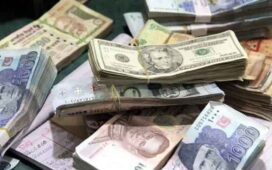
The rupee fell 1.2% last week to 87.5275 per dollar on Friday, marking its biggest weekly drop since December 2022.
| Photo Credit:
HEMANSHI KAMANI
Rupee is poised to remain one of Asia’s worst performers in the second half of the year, with US tariffs adding pressure to an already fragile economic recovery, analysts say.
Analysts at Deutsche Bank AG and Barclays Plc expect the currency to drop to new record lows by the year-end amid muted foreign inflows and headwinds from US tariffs. Meanwhile, the Chinese yuan, Indonesian rupiah, Malaysian ringgit and Philippine peso are projected to gain, according to estimates compiled by Bloomberg.
While most Asian nations reach US trade deals, India faces a 25% tariff rate as talks stall. The nation’s markets have already seen $11 billion in equity outflows as economic growth slows, while interest-rate cuts by the central bank eroded support for the currency. Further depreciation would amplify concerns over imported inflation.
The rupee is likely to “remain an underperformer in Asia,” said Dhiraj Nim, an economist and forex strategist at Australia & New Zealand Banking Group Ltd. in Mumbai. “I don’t think much inflow can be expected, especially with growth risk in the picture due to tariffs.”
Higher tariffs may shave off about 30 basis points from the gross domestic product growth, according to Barclays.
Markets will now look to the Reserve Bank of India’s policy meeting on Aug. 6 for its rate moves and cues for the rupee. The RBI delivered a surprise 50-basis-point rate cut in its last meeting and signaled a higher threshold for future easing.
While the near-record foreign-exchange reserves give the RBI room to intervene, any action to curb rupee losses is likely to be measured, as “tariff uncertainty limits the RBI’s motivation to aggressively push” rupee higher against the dollar, Citigroup economists led by Samiran Chakraborty wrote in a note.
The rupee fell 1.2% last week to 87.5275 per dollar on Friday, marking its biggest weekly drop since December 2022.
Still, not all analysts are bearish. Hopes linger that a delayed trade deal with Washington may still materialize, with India reportedly weighing concessions, including boosting imports from the US, while holding off on retaliatory measures.
“The key for markets and our rupee forecast is whether a trade deal is delayed but not denied,” said Michael Wan, senior currency analyst at MUFG Bank Ltd. He sees the rupee at 87 per dollar by end-December, compared with his earlier forecast of 84.50.
For now, headwinds for the rupee from sluggish foreign inflows remain.
“The bond market may not see significant inflows, as the RBI has indicated little room for further cuts,” said Chandresh Jain, EM Asia rates and FX markets strategist at BNP Paribas SA. Equities also look stretched, with high valuations and slowing economic growth, he said.
This week’s main economic events:
- Monday, Aug. 4: Melbourne Institute inflation
- Tuesday, Aug. 5: Indonesia 2Q GDP, Philippines CPI, South Korea CPI, Australia household spending, BOJ June meeting minutes, Singapore retail sales, Services PMI across Asia
- Wednesday, Aug. 6: RBI rate decision, New Zealand 2Q employment change, Thailand CPI, Japan labor cash earnings, Taiwan CPI and PPI
- Thursday, Aug. 7: Philippines 2Q GDP, China trade balance, Australia trade balance, New Zealand 2-yr inflation expectations, South Korea BoP current account balance, Malaysia industrial production
- Friday, Aug. 8: BOJ summary of opinions July meeting, Japan BoP current account balance, Taiwan trade balance
More stories like this are available on bloomberg.com
©2025 Bloomberg L.P.
Published on August 4, 2025




